(完整word版)食品工艺学(夏文水课件文稿)..
食品工艺学教学大纲说课稿精选全文
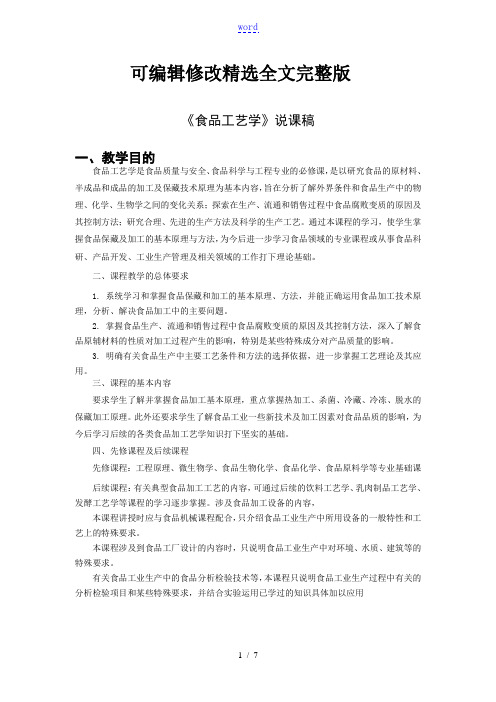
可编辑修改精选全文完整版《食品工艺学》说课稿一、教学目的食品工艺学是食品质量与安全、食品科学与工程专业的必修课,是以研究食品的原材料、半成品和成品的加工及保藏技术原理为基本内容,旨在分析了解外界条件和食品生产中的物理、化学、生物学之间的变化关系;探索在生产、流通和销售过程中食品腐败变质的原因及其控制方法;研究合理、先进的生产方法及科学的生产工艺。
通过本课程的学习,使学生掌握食品保藏及加工的基本原理与方法,为今后进一步学习食品领域的专业课程或从事食品科研、产品开发、工业生产管理及相关领域的工作打下理论基础。
二、课程教学的总体要求1. 系统学习和掌握食品保藏和加工的基本原理、方法,并能正确运用食品加工技术原理,分析、解决食品加工中的主要问题。
2. 掌握食品生产、流通和销售过程中食品腐败变质的原因及其控制方法,深入了解食品原辅材料的性质对加工过程产生的影响,特别是某些特殊成分对产品质量的影响。
3. 明确有关食品生产中主要工艺条件和方法的选择依据,进一步掌握工艺理论及其应用。
三、课程的基本内容要求学生了解并掌握食品加工基本原理,重点掌握热加工、杀菌、冷藏、冷冻、脱水的保藏加工原理。
此外还要求学生了解食品工业一些新技术及加工因素对食品品质的影响,为今后学习后续的各类食品加工艺学知识打下坚实的基础。
四、先修课程及后续课程先修课程:工程原理、微生物学、食品生物化学、食品化学、食品原料学等专业基础课后续课程:有关典型食品加工工艺的内容,可通过后续的饮料工艺学、乳肉制品工艺学、发酵工艺学等课程的学习逐步掌握。
涉及食品加工设备的内容,本课程讲授时应与食品机械课程配合,只介绍食品工业生产中所用设备的一般特性和工艺上的特殊要求。
本课程涉及到食品工厂设计的内容时,只说明食品工业生产中对环境、水质、建筑等的特殊要求。
有关食品工业生产中的食品分析检验技术等,本课程只说明食品工业生产过程中有关的分析检验项目和某些特殊要求,并结合实验运用已学过的知识具体加以应用五、课程教学总体安排(一)学时分配建议表学时分配建议表(二)推荐教材及参考书目1、教材:1)夏文水,食品工艺学,中国轻工,2008,第一版2)赵晋府,食品工艺学,中国轻工业, 2005年第二版2、参考书目1)曾庆孝,食品加工与保藏原理》,,化学工业, 20022)马长伟,曾名勇,食品工艺学导论,中国农业大学,20023)宋纪蓉,食品工程技术原理,化学工业, 20054)Dennis R.Heldman and Richard W..Hartel 著, 夏文水等译,食品加工原理,中国轻工业,2001(三)课程考核方式1、考核方式:考试2、成绩构成:平时成绩占30%,课程考试点70%六、课程教学内容及基本要求(一)绪论(4学时)1、教学目的通过讲授食品工艺学的研究对象和内容,食品科学发展历程,使用理解解食品加工的概念、食品加工原料的特性和要求、食品的质量因素及其控制、食品的腐败变质及其控制。
夏文水-食品工艺学-第一章绪论 第二节 食品加工工艺
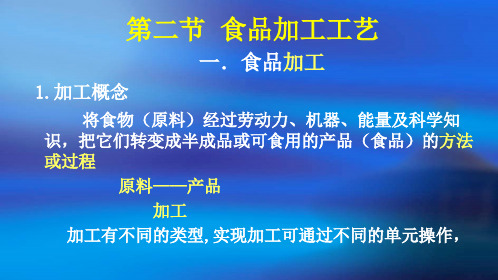
一.食品加工
1.加工概念
将食物(原料)经过劳动力、机器、能量及科学知 识,把它们转变成半成品或可食用的产品(食品)的方法 或过程
原料——产品 加工
加工有不同的类型,实现加工可通过不同的单元操作,
加工操作类型
预处理 清洗 挑拣 去皮 粉碎 单元操作 加热 干燥 冷却 冷冻 分离 蒸发 关键工序 杀菌 消毒 配方 食品添加剂如调味 防腐 包装 维持由于加工操作带来的产品的特征,有内 包装、外包装
可用工艺流程图来表示
3. 工艺特点
工艺与原料和产品联系在一起; 从原料到产品的整个过程 涉及到采用的加工方法或单元操作,如人工或机械 加工操作的次序或组合即工序
工艺决定了产品的质量;取决于工艺合理性和所采用 的加工技术;
工艺具有变化性、多样性和复杂性;可创新;
科学技术; 《本草纲目》 ,李时珍,1578年,1892种中药草;
二、食品工艺
1. 工艺概念
食品工艺就是将原料加工成半成品或将原料和半成 品加工成食品的过程和方法;
加工过程和方法就是由加工操作和加工步骤组合起 来的;整个过程是加工工艺流程,
2. 食品工艺流程
通过应用加工操作得到食品的工艺流程 例子: 桔子浓缩汁 速冻豌豆 果蔬罐头 消毒乳 土豆片
普通加工 复杂加工 精深加工
2. 加工目的
(1)满足消费Biblioteka 要求; (2)延长食品保藏期; (3)增加食品安全性; (4)提高食品附加值;
3. 食品加工的历史
用热空气干燥食品在1795年法国; 商业化冷冻食品鱼1862年; 西班牙在十七世纪盐制鱼; 罐头加热杀菌在1810年法国;尼古拉.阿培尔发明; 我国有悠久的历史: 《齐民要术》 ,贾思勰,533~534年,中国北方农业
食品工艺学课件

食品工艺学课件第一章绪论第一节食品的加工概念一、食物与食品食物——是人体生长发育、更新细胞、修补组织、调节机能必不可少的营养物质,也是产生热量保持体温、进行体力活动的能量来源。
食品——通过加工制作的事物统称之食品1. 食品的概念及分类对食品不一致的人关心的侧面不一致—不一致地区也有不一致的情况分类:食品分类的方法很多,能够按保藏方法分、按原料种类分、按原料与加工方法分、按产品特点分。
2. 食品的要求:外观、风味、营养卫生与要求、货架寿命、方便、功能性质二、加工工艺1.概念• 食品科学与工程领域的一些概念–食品科学:借用Food Science (Norman)的定义,食品科学能够定义为应用基础科学及工程知识来研究食品的物理、化学及生化性质及食品加工原理的一门科学。
-食品工艺五个基础框架1. 食品的基础研究领域(或者者称之为狭义食品科学):包含食品化学,研究食品的构成、结构、物化生化特点及加工与使用过程中的变化的一门科学。
2. 食品分析领域:分析食品产品及组分的质量特点、化学边的原理3. 食品微生物领域:环境对食品腐败的作用与微生物对食品本身及食品制造过程的影响、微生物的检验、公共健康等问题的一门科学4. 食品加工领域:即研究食品原材料特点、食品保藏原理、影响食品质量、包装及污染的加工因素、良好生产操作及卫生操作的一门科学——这也是本课程的要紧研究内容5. 食品工程领域:即研究食品加工过程中的工程原理及单元操作的科学,工程原理包含物料与能量平衡、热力学、流体;流体流淌、传热与传质等等。
食品工艺学•食品工艺学是应用化学、物理学、生物学、微生物学与食品工程原理等各方面的基础知识、研究食品资源利用、原辅材料选择、保藏加工、包装、运输与上述因素对食品质量货架寿命、营养价值、安全性等方面的影响的一门科学。
-食品加工的概念:在描述食品加工的概念之前,先熟悉一些典型食品的加工流程。
加工基本概念包含:–增加热能并升高温度–去除热能或者降低温度–去除水分或者降低水分含量–利用包装以维持由于加工操作带来的产品的特征2. 食品加工的目的:增加多样性;提供健康所需的营养素;为制造商提供利润;延长食品的储存时间食品加工过程或者多或者少都含有这些目的,但要加工一个特定产品其目的性可能各不相同–比如冷冻食品的目的要紧是保藏或者延长货架寿命–糖果工业的要紧目的是提供多样性–但是要达到各个产品的目的却并不简单,并不是买来设备就能够生产,或者达到生产出食品并赢利的目的•以橙汁与火腿肠为例第二节食品加工原料的特性与要求一、食品原料要紧构成二、影响原料加工的因素•原料采收运输基本原则–原料应该在其品质最佳的时候进行采收、屠宰或者用其他方法进行采集。
食品工艺学

o 食品工业是整个工业中吸纳城乡就业人数最 多、与农业关联度最强的产业。 •食品工业是国民经济的重要支柱产业
PPT文档演模板
食品工艺学
我国食品工业特色
白酒固体发酵,蒸馏技术 豆豉、酱油生产技术 蔬菜腌制(发酵)技术 肉类烟熏保藏
PPT文档演模板
食品工艺学
二、食品工艺
1. 工艺概念
• 食品工艺就是将原料加工成半成品或将原料和 半成品加工成食品的过程和方法;
• 加工过程和方法就是由加工操作和加工步骤组 合起来的;整个过程是加工工艺流程,
PPT文档演模板
食品工艺学
2. 食品工艺流程
通过应用加工操作得到食品的工艺流程 例子: • 桔子浓缩汁 • 速冻豌豆 • 果蔬罐头 • 消毒乳 • 土豆片
PPT文档演模板
食品工艺学
食品工业还存在一些问题:
o 食品质量安全百姓不太满意 o 经营方式较粗放 o 市场集中度较低 o 恶性竞争比较严重 o 品牌建设滞后 o 行业自律不足等
PPT文档演模板
食品工艺学
专栏1 2000年和2005年食品工业主要产品的产量(万吨)
产品
2000年 2005年 五年累计增长(%) 年均增长率(%)
4学时
第二章 食品的脱水 6学时
第三章 食品的热处理与杀菌 8学时
第四章 食品冷冻 6学时
第五章 食品的腌渍发酵和烟熏处理 4学时
第六章 食品的化学保藏 2学时
第七章 食品的辐射保藏 3 学时
第八章 食品加工工艺 3学时
共计 36学时
PPT文档演模板
食品工艺学
本课程教材及课程网页
(完整word版)食品工艺学(夏文水课件文稿)..

食品工艺学第一章绪论第一节食品的加工概念一、食物与食品1 食物——供人类食用的物质称为食物。
是人体生长发育、更新细胞、修补组织、调节机能必不可少的营养物质,也是产生热量保持体温、进行体力活动的能量来源。
除少数物质如盐类外,几乎全部来自动植物和微生物。
2 食品——经过加工制作的食物统称为食品。
食品的种类对食品不同的人关心的侧面不同;不同地区也有不同的情况食品分类的方法:按加工工艺分;按原料种类分;按产品特点分;按使用对象分:老年、儿童、婴儿、妇女、运动员、航空、军用。
二. 食品的功能食品对人类所发挥的作用;人类吃食品的目的;人类对食品的要求;1.营养功能(第一功能)蛋白质、碳水化合物(糖)、脂肪、维生素、矿物质、膳食纤维。
提供营养和能量,为了生存——营养功能(吃饱)。
2.感观功能(第二功能)为了满足视觉、触觉、味觉、听觉的需要,使多吃吃好。
外观:大小、形状、色泽、光泽、稠度;质构:硬度、粘性、韧性、弹性、酥脆;风味:气味、香臭。
味道酸、甜、苦、辣、咸、鲜、麻。
3.保健功能(第三功能新发展的功能)调节人体生理功能,起到增进健康、恢复疾病、延缓衰老、美容等作用。
三、食品的特性1.安全性无毒无害卫生;2.方便性食用使用运输;3.保藏性有一定的货架寿命。
四、加工工艺1.1.食品加工概念将食物(原料)经过劳动力、机器、能量及科学知识,把它们转变成半成品或可食用的产品(食品)的过程。
原料——产品加工加工预处理:清洗分离粉碎;单元操作:加热冷却干燥;关键工序:杀菌消毒;食品添加剂:调味保存;包装:维持由于加工操作带来的产品的特征。
2.食品加工的目的满足消费者要求;延长食品的保存期;增加多样性;提高附加值。
食品加工过程或多或少都含有这些目的,但要加工一个特定产品其目的性可能各不相同。
比如冷冻食品的目的主要是保藏或延长货架寿命;糖果工业的主要目的是提供多样性。
但是要达到各个产品的目的却并不简单,并不是买来设备就可以生产,或达到生产出食品并赢利的目的3.食品工艺根据技术上先进、经济上合理的原则,研究食品的原材料、半成品和成品的加工过程和方法的一门应用科学。
(完整版)食品工艺学
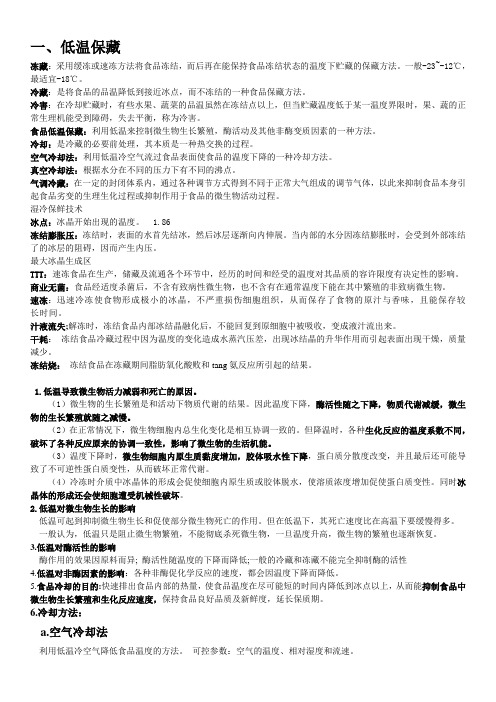
一、低温保藏冻藏:采用缓冻或速冻方法将食品冻结,而后再在能保持食品冻结状态的温度下贮藏的保藏方法。
一般-23~-12℃,最适宜-18℃。
冷藏:是将食品的品温降低到接近冰点,而不冻结的一种食品保藏方法。
冷害:在冷却贮藏时,有些水果、蔬菜的品温虽然在冻结点以上,但当贮藏温度低于某一温度界限时,果、蔬的正常生理机能受到障碍,失去平衡,称为冷害。
食品低温保藏:利用低温来控制微生物生长繁殖,酶活动及其他非酶变质因素的一种方法。
冷却:是冷藏的必要前处理,其本质是一种热交换的过程。
空气冷却法:利用低温冷空气流过食品表面使食品的温度下降的一种冷却方法。
真空冷却法:根据水分在不同的压力下有不同的沸点。
气调冷藏:在一定的封闭体系内,通过各种调节方式得到不同于正常大气组成的调节气体,以此来抑制食品本身引起食品劣变的生理生化过程或抑制作用于食品的微生物活动过程。
湿冷保鲜技术冰点:冰晶开始出现的温度。
1.86冻结膨胀压:冻结时,表面的水首先结冰,然后冰层逐渐向内伸展。
当内部的水分因冻结膨胀时,会受到外部冻结了的冰层的阻碍,因而产生内压。
最大冰晶生成区TTT:速冻食品在生产,储藏及流通各个环节中,经历的时间和经受的温度对其品质的容许限度有决定性的影响。
商业无菌:食品经适度杀菌后,不含有致病性微生物,也不含有在通常温度下能在其中繁殖的非致病微生物。
速冻:迅速冷冻使食物形成极小的冰晶,不严重损伤细胞组织,从而保存了食物的原汁与香味,且能保存较长时间。
汁液流失;解冻时,冻结食品内部冰结晶融化后,不能回复到原细胞中被吸收,变成液汁流出来。
干耗:冻结食品冷藏过程中因为温度的变化造成水蒸汽压差,出现冰结晶的升华作用而引起表面出现干燥,质量减少。
冻结烧:冻结食品在冻藏期间脂肪氧化酸败和tang氨反应所引起的结果。
1.低温导致微生物活力减弱和死亡的原因。
(1)微生物的生长繁殖是和活动下物质代谢的结果。
因此温度下降,酶活性随之下降,物质代谢减缓,微生物的生长繁殖就随之减慢。
夏文水-食品工艺学-第五章-第一节食品的腌制保藏[52页]
![夏文水-食品工艺学-第五章-第一节食品的腌制保藏[52页]](https://img.taocdn.com/s3/m/34ea68a033687e21ae45a988.png)
15.6 0.900 14.11
21.3 0.850 22.40
蔗糖在水中的溶解度很大,饱和溶液的百分浓度可达67.5%,以质量摩尔浓度表示则为 6.08mol/kg,该溶液的渗透压很高,足以是使微生物发生脱水,严重地抑制微生物的生长繁 殖,这是蔗糖溶液能够防腐的主要原理。
表5-2 20℃时蔗糖溶液的渗透压
前景广阔
酱腌菜产品在国内有着巨大的消费市场,不论是日常佐 餐,还是旅游、野餐等,都是必不可少的佳品。根据酱腌菜 的包装和档次,在不同的市场销售。
普通的酱腌菜产品一般集中在农贸市场,中小商店,由于包装 简易和产量较少,通常供应本地市场。
大型企业的产品和一些知名品牌,包装精美、品质优良,保质 期长,可以在全国范围销售,并有实力进入超市、大型商场等 场所,日销售量大,影响面广,具有较大的经济效益。
布尔改进 Π =[ρ1/(100Mr)]cRT
式中: Π ── 渗透压(MPa) ρ1 ── 溶剂的密度(kg·m-3或g·L-1) R ── 气体常数(8.314J·K-1·mol-1) T ── 绝对温度(K) C ── 溶液浓度(100g或kg溶剂中溶质的g数或kg数) Mr ── 溶质相对分子质量
图5-3腌鲱鱼时盐浓度对食盐的内渗量的影响
1干盐;4,5>20%
(三)温度
➢由扩散渗透理论可知,温度 越高,扩散渗透速度越迅速; ➢选择适宜的温度必须考虑微 生物的作用; ➢肉类在室温较高下容易腐败, 一般在低温10℃以下进行. ➢利用高温加速腌制,盐水锅 中煮干;
图5-4食盐水腌制小沙丁鱼时食盐的渗透速度
第五章 食品的腌渍发酵和烟熏处理
第一节 食品的腌渍保藏 第二节 食品的发酵保藏 第三节 食品的烟熏处理 第四节 半干半湿食品
食品工艺学课件(PPT 65张)
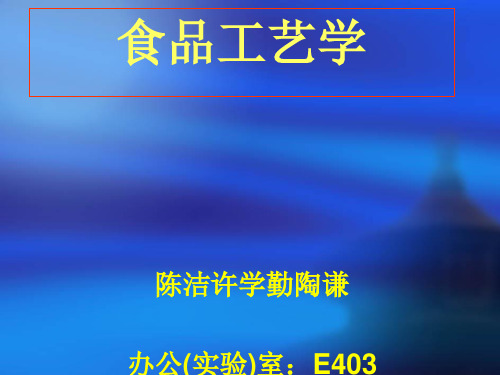
本课程教材及课程网页
1. 《食品工艺学 》 , 夏文水主编,中国轻
工业出版社,2007,1 国家级规划教材
2. 食品工艺学国家精品课程网页 /jpkc
主要参考书
1. 《食品加工原理》,夏文水等译, 2001,中国轻工业出版社; 2. Principles of Food Processing Dennis R.Heldman and Richard W.Hartel 1997
1. 安全性
• 指食品无毒、无害、无副作用;与“食品
卫生”为同义词;
•有微生物、化学、物理方面
微生物:细菌总数、致病菌、霉菌等;
化学:重金属铅砷汞、农药残留、药残、
激素、滥用化学添加剂或用量超标;
物理:杂质、外形、异物
2. 保藏性
有一定的货架寿命或保质时间
食品在一定时间内保持品质或食品品质降低
食品工艺学其他参考书
1.《肉制品加工原理与技术》,夏文水主编,2003, 化学工业出版社; 2. 《乳制品生产技术》,张国农等译,2002,中国轻 工业出版社; The Technology of Dairy Products,1998,UK, Ralph Early 3.《水产品加工技术》,夏文水等译 , 2002,中国轻 工业出版社; Fish Processing Technology, 1997,UK, G.M.Hall
到不能被消费者接受的时间被定义为食品货 架寿命或货架期;
取决于加工方法、包装和贮藏条件; 消费者选择食品的依据之一;
3. 方便性
便于食用、携带、运输、贮藏;
易拉罐、易拉盖、易拉袋; 外包装、纸盒、箱子等;
净菜、配菜;
开袋即食
四、食品管理
食品工艺学夏文水

二 关于食品科学
借用Food Science (Norman)的定义 食品科学可以定义为应用基础科学及工程 知识来研究食品的物理、化学及生化性质及 食品加工原理的一门科学。
食品科学
食品加工
食品分析
食品科学
食品工程
食品微生物
五个基础框架
1. 食品的基础研究领域(或者称之为狭义食品科学):包括 食品化学,研究食品的组成、结构、物化生化特点及加工和 使用过程中的变化的一门科学。 2. 食品微生物领域:环境对食品腐败的作用以及微生物对食品 本身及食品制造过程的影响、微生物的检验、公共健康等问 题的一门科学 3. 食品加工领域:即研究食品原材料特点、食品保藏原理、 影响食品质量、包装及污染的加工因素、良好生产操作及 卫生操作的一门科学——这也是本课程的主要研究内容 4.食品工程领域:即研究食品加工过程中的工程原理及单元操 作的科学,工程原理包括物料与能量平衡、热力学、流体; 流体流动、传热与传质等等。 5.食品分析领域:分析食品产品及组分的质量特点、化学边的 原理
•原料一经采收或屠宰后即进入变质过程,品质决不会 随贮藏时间的延长而变好
影响(原料)品质的因素: 微生物的影响; 酶在活组织、垂死组织和死组织中的作用; 物理化学因素 热、冷、水分、氧气、光、 时间
2. 按照变质可能性将原料分类
极易腐败原料(1天~2周) 如肉类和大多数水果和部分蔬菜 采收(屠宰、切割)、搬运、包装、贮藏条件可能强烈 影响其品质 冷藏温度应该合理(某些果蔬会冻害) 中等腐败性原料(2周~2月) 柑橘、苹果和大多数块根类蔬菜 冷害问题 稳定的原料(2~8月) 粮食谷物、种子和无生命的原料如糖、淀粉和盐等
四、加工工艺
1. 食品加工概念
(完整版)食品工艺学
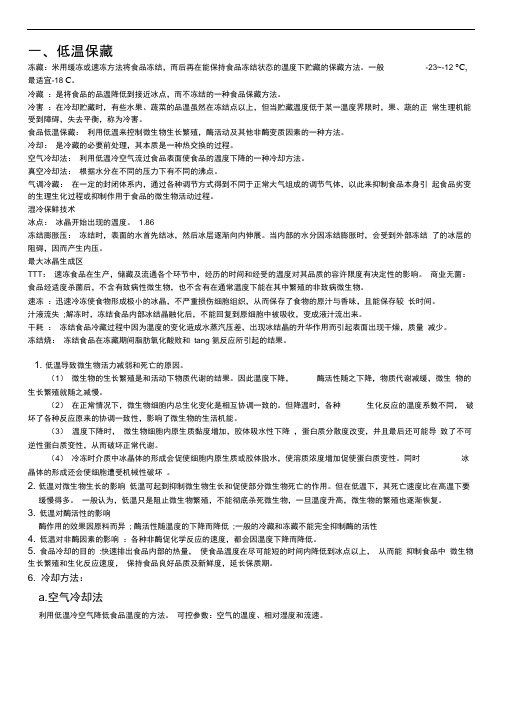
一、低温保藏冻藏:米用缓冻或速冻方法将食品冻结,而后再在能保持食品冻结状态的温度下贮藏的保藏方法。
一般-23~-12 °C,最适宜-18 C。
冷藏:是将食品的品温降低到接近冰点,而不冻结的一种食品保藏方法。
冷害:在冷却贮藏时,有些水果、蔬菜的品温虽然在冻结点以上,但当贮藏温度低于某一温度界限时,果、蔬的正常生理机能受到障碍,失去平衡,称为冷害。
食品低温保藏:利用低温来控制微生物生长繁殖,酶活动及其他非酶变质因素的一种方法。
冷却:是冷藏的必要前处理,其本质是一种热交换的过程。
空气冷却法:利用低温冷空气流过食品表面使食品的温度下降的一种冷却方法。
真空冷却法:根据水分在不同的压力下有不同的沸点。
气调冷藏:在一定的封闭体系内,通过各种调节方式得到不同于正常大气组成的调节气体,以此来抑制食品本身引起食品劣变的生理生化过程或抑制作用于食品的微生物活动过程。
湿冷保鲜技术冰点:冰晶开始出现的温度。
1.86冻结膨胀压:冻结时,表面的水首先结冰,然后冰层逐渐向内伸展。
当内部的水分因冻结膨胀时,会受到外部冻结了的冰层的阻碍,因而产生内压。
最大冰晶生成区TTT:速冻食品在生产,储藏及流通各个环节中,经历的时间和经受的温度对其品质的容许限度有决定性的影响。
商业无菌:食品经适度杀菌后,不含有致病性微生物,也不含有在通常温度下能在其中繁殖的非致病微生物。
速冻:迅速冷冻使食物形成极小的冰晶,不严重损伤细胞组织,从而保存了食物的原汁与香味,且能保存较长时间。
汁液流失;解冻时,冻结食品内部冰结晶融化后,不能回复到原细胞中被吸收,变成液汁流出来。
干耗:冻结食品冷藏过程中因为温度的变化造成水蒸汽压差,出现冰结晶的升华作用而引起表面出现干燥,质量减少。
冻结烧:冻结食品在冻藏期间脂肪氧化酸败和tang 氨反应所引起的结果。
1. 低温导致微生物活力减弱和死亡的原因。
(1)微生物的生长繁殖是和活动下物质代谢的结果。
因此温度下降,酶活性随之下降,物质代谢减缓,微生物的生长繁殖就随之减慢。
食品工艺学课件
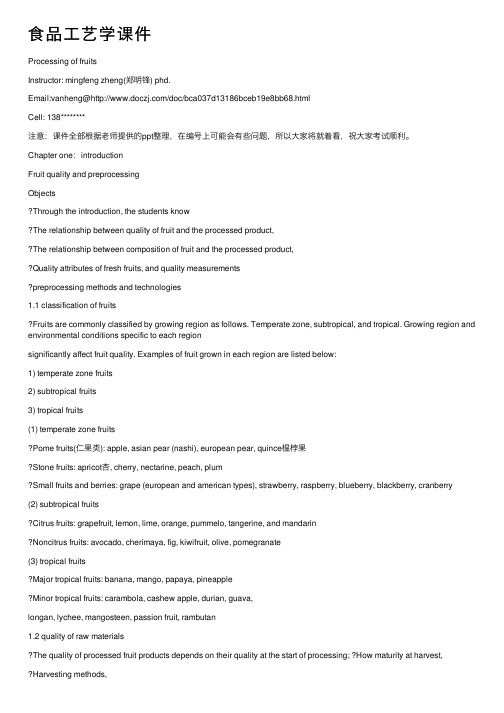
⾷品⼯艺学课件Processing of fruitsInstructor: mingfeng zheng(郑明锋) phd.Email:vanheng@/doc/bca037d13186bceb19e8bb68.htmlCell: 138********注意:课件全部根据⽼师提供的ppt整理,在编号上可能会有些问题,所以⼤家将就着看,祝⼤家考试顺利。
Chapter one:introductionFruit quality and preprocessingObjectsThrough the introduction, the students knowThe relationship between quality of fruit and the processed product,The relationship between composition of fruit and the processed product,Quality attributes of fresh fruits, and quality measurementspreprocessing methods and technologies1.1 classification of fruitsFruits are commonly classified by growing region as follows. Temperate zone, subtropical, and tropical. Growing region and environmental conditions specific to each regionsignificantly affect fruit quality. Examples of fruit grown in each region are listed below:1) temperate zone fruits2) subtropical fruits3) tropical fruits(1) temperate zone fruitsPome fruits(仁果类): apple, asian pear (nashi), european pear, quince榅桲果Stone fruits: apricot杏, cherry, nectarine, peach, plumSmall fruits and berries: grape (european and american types), strawberry, raspberry, blueberry, blackberry, cranberry (2) subtropical fruitsCitrus fruits: grapefruit, lemon, lime, orange, pummelo, tangerine, and mandarinNoncitrus fruits: avocado, cherimaya, fig, kiwifruit, olive, pomegranate(3) tropical fruitsMajor tropical fruits: banana, mango, papaya, pineappleMinor tropical fruits: carambola, cashew apple, durian, guava,longan, lychee, mangosteen, passion fruit, rambutan1.2 quality of raw materialsThe quality of processed fruit products depends on their quality at the start of processing; How maturity at harvest, Harvesting methods,Post harvest handling proceduresMaintenance in fresh fruits between harvest and process initiation.Quality attributes of fresh fruitsAppearance、exture factors、flavor components、nutritional quality、safety factorsAppearance factorsSize、shape、color、freedom from defects and decay.Texture factorsFirmness, crispness, juiciness.Flavor componentsSweetness, sourness (acidity), astringency, (收敛),bitterness, aroma, off-flavors,Nutritional qualityFruit's content of vitamins (a and c are the most important in fruits), minerals, dietary fiber, carbohydrates, proteins. Safety factorsResidues of pesticides, presence of heavy metals, mycotoxins produced by certain species of fungi, microbial contamination.1.3 losses in fresh fruits after harvastWater loss,Physical injuries,physiological breakdown, decayLoss of acidity, flavor, color, and nutritive valueFactors influence fruit qualityIn the orchard,During transportation,Throughout the handling system (sorting, sizing, ripening, and storage).The total time between harvesting and processingMinimizing the delays throughout the post harvest handling system greatly reduces finality loss, especially in highly perishable fruits such as strawberries, blackberries, apricots, and cherries.1.4 contribution of fruits to human nutritionEnergy (calories)VitaminsMineralsDietary fiberThe us. Department of agriculture and other organizations currently encourage consumers to participate in the "five a day" program which focuses on consumption of five servings of either fruit or vegetables each day.Energy (calories)(1) carbohydrates: banana, breadfruit, raisin葡萄⼲(2) proteins & amino acids: nuts, dried apricot and fig(3) fats. Avocado, olive, nutsFruits typically contain between 10% and 25% carbohydrates, a small amount (less than1.0%) of proteins, and a very small amount (less than 0.5 %) of fat. Carbohydrates, sugars,and starches are broken down to co2, water, and energy during metabolism. Carbohydrates and fats provide most of the calories the body requires for heat and energy.Vitamins(1) fresh fruits and vegetables contribute about 91% of vitamin c, 48% of vitamin a, 27% of vitamin b6, 17% of thiamin硫胺(维⽣素b1) to diet.(2) the following fruits are important contributors (based on their vitamin content and the amount consumed) to the supply of indicated vitamins in the u.s. Diet:*vitamin a: apricot, peach, cherry, orange, watermelon, cantaloupe*vitamin c: strawberry, orange, grapefruit, banana, apple, cantaloupe* niacin烟酸: peach, banana, orange, apricot"*riboflavin核黄素: banana, peach, orange, apple* thiamin: orange, banana, grapefruit, appleMinerals(1) fresh fruits and vegetables contribute about 26% of the magnesium镁and 19% of the iron to the u.s. Diet.(2) the following fruits are important contributors to the supply of indicated minerals in the us. Diet:* potassium钾: banana, peach, orange, apple* phosphorus磷: banana, orange, peach, raisin, fig*calcium: tangerine, grapefruit, orange* iron: strawberry, banana, apple, orangeDietary fiber(1) all fruits and nuts contribute to the dietary fiber in the diet. Dietary fiber consists of cellulose, hemicellulose, lignin⽊质素, and pectic substances, which are derived primarily from fruit cell walls and skin.(2) the dietary fiber content of fruits ranges from 0.5-1.5% (fresh weight basis).(3) dietary fiber plays an important role in relieving constipation by increasing water-holding capacity of feces. Its consumption is also linked to decreased incidence of cardiovascular disease, diverticulosis, and colon cancer.factors influefncing composition and quality of fruitsPreharvest factors(1) genetic: selection of cultivars, differences in raw fruit composition, durability, and response to processing. Fruit cultivars grown for fresh market sale will not be the optimal cultivars for processing.(2) climatic: temperature, light, wind--climatic factors may have a strong influence on nutritional quality of fruits. Light intensity significantly affects vitamin concentration, and temperature influences transpiration rate, which will affect mineral uptake and metabolism. ?(3) cultural practices: soil type, soil nutrient and water supply, pruning修剪, thinning, pest control-fertilizer addition may significantly affect the mineral content of fruit.1. 5 maturity at harvest and harvesting methodMaturity at harvest is one of the primary factors affecting fruit composition, quality, and storage life. Although most fruits reach peak eating quality when harvested fully ripe, they are usually picked mature, but not ripe, to decrease mechanical damage during postharvest handling. Harvesting may also mechanically damage fruit; therefore, choice of harvest methodshould allow for maintenance of quality.Postharvest factors1) environmental,2) handling methods,3) time period between harvesting and consumption(1) environmentalTemperature, relative humidity, atmospheric composition,(2) handling methodsPostharvest handling systems involve the channels through which harvested fruit reaches the processing facility or consumer. Handling methods should be chosen such that they maintain fruit quality and avoid delays.(3) time period between harvesting and consumptionDelays between harvesting and cooling or processing may result in direct losses (due to water loss and decay) and indirect losses (decrease in flavor and nutritional quality).Fruit maturity, ripening, and quality relationshipsMaturity at harvest is the most important factor that determines storage life and final fruit quality. Immature fruits are of inferior quality when ripened. Overripe fruits are likely to become soft and with insipid flavor soon after harvest. Fruits picked either too early or too late in the season are more susceptible to physiological disorders and have a shorter storage life than those picked at mid-season.Maturity and ripeningIn general, fruits become sweeter, more colorful, and softer as they mature.Some fruits are usually picked mature but unripe so that they can withstand the postharvest handling system when shipped long distances. Most currently used maturity indices are based on a compromise between those indices that would ensure the best eating quality to the consumer and those that provide the needed flexibility in transportation and marketing.Carbohydrates(碳⽔化合物)Carbohydrates : fresh fruits vary greatly in their carbohydrate content, with a general range being between 10% and 25%;. The texture, taste, and food value of a fresh fruit is related to its carbohydrate content. Sucrose, glucose, and fructose are the primary sugars found in fruits.Fructose is sweeter than sucrose, and sucrose is sweeter than glucose.Starch is converted to sugar as the fruits mature and ripen.Proteins(蛋⽩质)Fruits contain less than 1% protein (as opposed to 9-20% protein in nuts such as almond, and walnut). Changes in the level and activity of proteins resulting from permeability changes in cell membranes may be involved in chilling injury. Enzymes, which catalyze metabolic processes in fruits, are proteins that are important in the reactions involved in fruit ripening and senescence.Enzymes in fruits:(Organic acids(有机酸)Organic acids are important intermediate products of metabolism. The krebs (tca) cycle is the main channel for the oxidation of organic acids in living cells, and it provides the energy required for maintenance of cell integrity. Organic acids aremetabolized into manyconstituents, including amino acids, which are the building blocks of proteins.Citric acid、malic acid、tartaric acid、oxalic acidPigments(⾊素)Pigments undergo many changes during the maturation and ripening of fruits.(1) loss of chlorophyll (green color), which is influenced by ph changes, oxidative conditions, and chlorophyllase action(2) synthesis and/or revelation of carotenoids (yellow and orange colors)(3) development of anthocyanins (red, blue, and purple colors.Beta-carotene is a precursor to vitamin a. Carotenoids are very stable and remain intact in fruit tissues, even when extensive senescence has occurred.Phenolic compounds(酚类化合物)Total phenolic content is higher in immature fruits than in mature fruits and is the main substrate involved in enzymatic browning of cut, or otherwise damaged, fruit tissues when exposed to air.Enzymatic browning(酶促褐变)Enzymatic browning occurs due to the oxidation of phenolic compounds and is mediated, in the presence of o2, by the enzyme polyphenoloxidase (ppo). The initial product of oxidation is usually o-quinone, which is highly unstable and undergoes polymerization to yield brown pigments of higher molecular weight. Polyphenoloxidase catalyzes the following tworeactions:Volatiles(挥发性)Volatiles are responsible for the characteristic aroma of fruits. They are present in extremely small quantities (c <100µg/g fresh wt.).Volatile compounds are largely esters(酯), alcohols, acids, aldehydes(醛), an d ketones (low-molecular weight compounds).VitaminsThe water-soluble vitamins includeVitamin c,Thiamin硫胺(维⽣素b1),Riboflavin核黄素,Niacin烟酸, vitamin b6,Folacin叶酸, vitamin b12, biotin维⽣素h. Fat soluble vitamins include vitamins a, d, e, and k.Fat-soluble vitamins are less susceptible to postharvest losses.Vitamin cAscorbic acid is most sensitive to destruction when the commodity is subjected to adverse handling and storage conditions. Losses are enhanced by extended storage, highertemperatures, low relative humidity, physical damage, and chilling injury. Postharvest losses in vitamins a and b are usually much smaller than losses in vitamin c.1.7 biological factors involved in postharvest deterioration (变坏) of fruits ?Respiration (呼吸作⽤)Ethylene productionTranspiration (蒸腾作⽤)Physiological disordersPhysical damagePathological breakdownRespirationStored organic materials (carbohydrates, proteins, fats) are broken down into simple end products with a release of energy. Oxygen (o2) is used in this process, and carbon dioxide (co2) is produced.The loss of stored food reserves in the commodity during respiration hastens senescence as the reserves that provide energy to maintain the commodity's living status are exhausted. ?Food value (energy value) for the consumer is lost; it has reduced flavor quality, with sweetness especially being lost; and salable dry weight is lost (especially important for commodities destined for dehydration). The energy released as heat.Ethylene productionEthylene, the simplest of the organic compounds affecting the physiological processes of plants, is produced by all tissues of higher plants. As a plant hormone, ethylene regulates many aspects of growth development, and senescence and is physiologically active in traceamounts (less than 0.1 ppm).Transpiration or water lossWater loss is the main cause of deterioration because it results not only direct quantitative.Losses (loss of salable weight) hut also in loss of its appearance, loss of cripsness, andjuiciness), and nutritional quality.The dermal system (outer protective coverings) governs the regulation of water loss by the commodity.Physiological disorders(1) freezing injury :usually results in immediate collapse of the tissues and total loss.(2) chilling injury when fruits (mainly those of tropical and subtropical origin) are held at temperatures above their freezing point and below 5-15℃, depending on the commodity. ?(3) heat injury results from exposure to direct sunlight or to excessively high temperatures.Symptoms include surface scalding, uneven ripening, excessive softening, and desiccation. ?(4) very low (<1%) oxygen and/or elevated (>20%) carbon dioxide concentration can result in physiological breakdown of all fruits.Physical damageVarious types of physical damage (surface injuries, impact bruising, vibration bruising, etc.) Are major contributors to deterioration. Mechanical injuries are not only unsightly, but also accelerate water loss, stimulate higher respiration and ethylene production rates, and favor decay incidence.Pathological breakdownDecay is one of the most common or apparent causes of deterioration; however, attack by many microorganisms usually follows mechanical injury or physiological breakdown, which allows entry to the microorganism. Pathogens can infect healthy tissues and become the primary cause of deterioration.Environmental factors influencing deterioration of fruits(影响⽔果变坏的环境因素)Temperature,Relative humidity,Air movement,Atmospheric composition,Ethylene,Harvesting procedures Postharvest handling proceduresDumping、Sorting、Sizing、Cooling、Storage、RipeningDumping:Fresh fruits should be handled with care throughout the postharvest handling system in order to minimize mechanical injuries. Dumping in water or in flotation tanks should be used for fruits. If dry dumping systems are used, they should be well padded bruising. Sorting:Manual sorting is usually carried out to eliminate fruit exhibiting defects or decay. For some fruits, it may also be necessary to sort the fruit into two or more classes of maturity or ripeness.Mechanical sorters, which operate on the basis of color, soluble solids, moisture, or fat content, are being implemented and may greatly reduce time and labor requirements. Sizing:In some cases, sizing the fruits into two or more size categories may be required before processing. Sizing can be done mechanically on the basis of fruit dimension or by weight.Mechanical sizing can be a major source of physical damage to the fruit if the machines are not adequately padded and adjusted to the minimum possible fruit drop heights Ripening:Ripening before processing may be required for certain fruits (banana, kiwifruit, mango, papaya, peach, pear, plum, melon) that are picked mature but unripe. Ethylene treatment can be used to obtain faster and more uniform ripening. The optimum temperature range for ripening is 15-25℃and, within this range, the higher the temperature, the faster the ripening. Relative humidity should be maintained between 90% and 95 % during ripening. Cooling:Cooling is utilized to remove field heat and lower the fresh fruit's temperature to near its optimum storage temperature. Cooling can be done using cold water (hydrocooling) or cold air (forced-air cooling or "pressure cooling"). Highly perishable fruits, such as strawberries, bush berries, and apricots, should be cooled to near 4℃within six hours of harvest. Other fruits should be cooled to their optimum temperature within twelve hours of harvest. Storage:Short-term or long-term storage of fresh fruits may be needed before processing to regulate the product flow and extend the processing season. The relative humidity in the storage facility should be kept between 90% and 95%.To reduce decay, elevated c02 (15-20%) may be added to the atmosphere within pallet covers for strawberries, bush berries, and cherries, and sulfur dioxide (200 ppm) fumigation may be used on grapes.1.8 quality measurementsMany quality measurements can be made before a fruit crop is picked in order to determine if proper maturity or degree of ripeness has developed.ColourColour may be measured with instruments or by comparing the colour of fruit on the tree with standard picture charts. TextureTexture may be measured by compression by hand or by simple type of plungers.Soluble solidsAs fruit mature on the tree its concentration of juice solids, which are mostly sugars, changes. The concentration of soluble solids in the juice can be estimated with arefractometer or a hydrometer液体⽐重计.Acid contentThe acid content of fruit changes with maturity and affects flavour. Acid concentration can be measured by a simple chemical titration on the fruit juice. But for many fruits the tartness and flavour are really affected by the ratio of sugar to acid. Sugar to acid ratioIn describing the taste of tartness of several fruits and fruit juices, the term "sugar to acid ratio" or "brix to acid ratio" are commonly used. The higher the brix the greater the sugar concentration in the juice; the higher the "brix to acid ratio" the sweeter and lees tart is the juice.1.9 preprocessing1.9.1 harvestingThe above and other measurements, plus experience, indicate when fruit is ready for harvesting and subsequent processing.1.9.2 reception - quality and quantity1.9.3 temporary storage before processing1.9.4 washingHarvested fruit is washed to remove soil, micro-organisms and pesticide residues.Fruit washing is a mandatory processing step; it would be wise to eliminate spoiled fruit before washing in order to avoid the pollution of washing tools and/or equipment and the contamination of fruit during washing.1.9.5 sortingFruit sorting covers two main separate processing operations:Removal of damaged fruit and any foreign bodies (which might have been left behind after washing);Qualitative sorting based on organoleptic criteria and maturity stage.Mechanical sorting for size is usually not done at the preliminary stage. The most important initial sorting is for variety and maturity.1.9.6 trimming and peeling (skin removal)This processing step aims at removing the parts of the fruit which are either not edible or difficult to digest especially the skin.Up to now the industrial peeling of fruit and vegetables was performed by three procedures: Mechanically;By using water steam;Chemically; this method consists in treating fruit and vegetables by dipping them in a caustic soda solution at a temperature of 90 to 100°c; the concentration of this solution as well asthe dipping or immersion time varying according to each specific case.1.9.7 cuttingThis step is performed according to the specific requirements of the fruit processing technology.1.9.8 blanchingA brief heat treatment to vegetables some fruits to inactivate oxidative enzyme systems such as catalase, peroxidase, polyphenoloxidase, ascorbic acid oxidase, and lipoxygenase. ?When the unblanched tissue is disrupted or bruised and exposed to air, these enzymes come in contact with substrates causing softening, discoloration, and the production of off flavors. ?It is most often standard practice to blanch fruits in order to prevent quality deterioration. ?Although the primary purpose of blanching is enzyme inactivation.There are several other benefits blanching initially cleanses the product;Decreases the microbial load,Preheats the product before processing.Softens the fruit, facilitates compact packing in the can.Expell intercellular gases in the raw fruitImproved heat transfer during heat processing.Water blanching is generally of the immersion type or spray type as the product moves on a conveyor.Steam blanching often involves belt or chain conveyors upon which the product moves through a tunnel containing live steam.adequacy of blanching is usually based on inactivation of one of the heat resistant enzymes (peroxidase or polyphenol oxidase).During the blanching process, it is imperative that certain enzymes that have the potential to cause flavour and textural changes be inactiviated. The process involves a brief heattreatment applied to most vegetables and also to some fruits in order to inactivate oxidative enzyme system such as catalase, peroxidase, polyphenoloxidase,ascorbic acid oxidase, and lipoxygenase.When unblanched tissue is disrupted or bruised and exposed to air,these enzymes come in contact with substrate causing softening,discoloration, and the production of off-flavours.Since this action can potentially occur during the period prior to heat processing, it is most often standard practice to blanch fruits in order to prevent quality deterioration.1.9.9 ascorbic/citric acid dipAscorbic acid or vitamin c minimises fruit oxidation primarily by acting as an antioxidant and itself becoming oxidised in preference to catechol⼉茶酚-tannin compounds.It has been found that increased acidity also helps retard oxidative colour changes and so ascorbic acid plus citric acid may be used together. Citric acid further reacts with (chelates) metal ions thus removing these catalysts of oxidation from the system.1.9.10 sulphur dioxide treatmentSulphur dioxide may function in several ways:Sulphur dioxide is an enzyme poison against common oxidising enzymes;It also has antioxidant properties; i.e., it is an oxygen acceptor (as is ascorbic acid);Further so2 minimises non enzymatic maillard type browning by reacting with aldehyde醛groups of sugars so that they are no longer free to combine with amino acids;Sulphur dioxide also interferes with microbial growth.In many fruit processing pre-treatments two factors must be considered:Sulphur dioxide must be given time to penetrate the fruit tissues;So2 must not be used in excess because it has a characteristic unpleasant taste and odour, and international food laws limit the so2 content of fruit products, especially of those which are consumer oriented (e.g. Except semi-processed products oriented to further industrial utilisation).5.2.11 sugar syrupSugar syrup addition is one of the oldest methods of minimising oxidation.Sugar syrup minimises oxidation by coating the fruit and thereby preventing contact withatmospheric oxygen.Sugar syrup also offers some protection against loss of volatile 挥发性的fruit esters 酯and itcontributes sweet taste to otherwise tart fruits.It is common today to dissolve ascorbic acid and citric acid in the sugar syrup for addedeffect or to include sugar syrup after an so 2 treatment.QuestionsWhat factors influence the quality of fruits after harvest?How to maintain the fruit in good quality before the processing begin?第⼀节果蔬原料特性新鲜果蔬原料的特点 ? 果蔬原料的化学成分原料的化学成分与加⼯的关系1.新鲜果蔬原料的特点易腐性、季节性、区域性2.果蔬中的化学成分(chemical composition in fruits and vegetables )3.化学成分与加⼯的关系(relation between chemical composition and processing )3.1 ⽔分(water)果蔬中⽔的含量:⼤多数在80%以上,含⽔量⾼的如冬⽠(wax gourd)可达96%以上。
食品工艺学完整版

食品工艺学完整版食品工艺学是一门研究食品的生产、加工、保藏、包装和流通等环节的科学。
它涵盖了食品原料的选择、加工方法、产品质量控制、食品安全等多个方面,旨在确保食品的安全、营养和美味。
在食品生产过程中,食品工艺学发挥着至关重要的作用。
在原料选择方面,食品工艺学通过对原料的化学成分、物理性质和微生物学特性等进行分析,确保原料符合食品安全和质量标准。
在加工方法方面,食品工艺学研究了各种加工技术,如热处理、冷冻、干燥、发酵等,以提高食品的营养价值和延长保质期。
食品工艺学还注重产品质量控制,通过建立严格的生产流程和质量检测体系,确保产品的稳定性和一致性。
食品工艺学还关注食品安全问题。
食品安全是食品工艺学的核心目标之一,它涉及到食品中微生物、化学物质和物理因素等可能对人体健康造成危害的因素。
食品工艺学通过研究食品中微生物的生长和繁殖规律,开发出有效的杀菌和防腐技术,以防止食品变质和食源性疾病的发生。
同时,食品工艺学还关注食品中的化学物质残留问题,通过建立严格的质量控制标准,确保食品中化学物质残留量在安全范围内。
食品工艺学还涉及到食品的包装和流通环节。
食品包装不仅能够保护食品,延长其保质期,还可以提升产品的美观度和市场竞争力。
食品工艺学研究了各种包装材料的选择和包装技术的应用,以确保食品在流通过程中的安全和卫生。
食品工艺学还关注食品的流通环节,通过建立有效的物流体系,确保食品从生产地到消费者手中的新鲜度和品质。
食品工艺学是一门综合性的学科,它涉及到食品生产的各个环节,旨在确保食品的安全、营养和美味。
随着科技的进步和消费者对食品安全和品质要求的提高,食品工艺学将继续发展,为人们提供更加安全、健康和美味的食品。
食品工艺学完整版食品工艺学不仅仅是一门科学,它还是一种艺术,一种对食物的深刻理解和创新。
在食品工艺学的世界里,每一个细节都至关重要,从原料的选择到最终的成品,每一个步骤都充满了科学和艺术的结合。
在原料的选择上,食品工艺学要求我们对食材有深入的了解。
食品工艺学课件
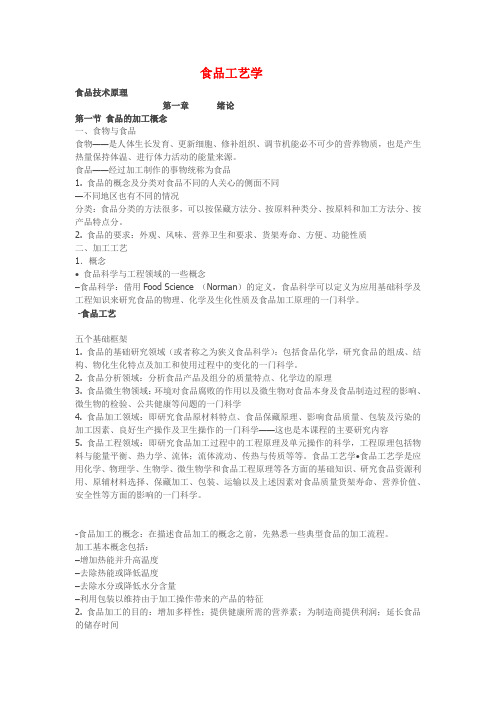
食品工艺学食品技术原理第一章绪论第一节食品的加工概念一、食物与食品食物——是人体生长发育、更新细胞、修补组织、调节机能必不可少的营养物质,也是产生热量保持体温、进行体力活动的能量来源。
食品——经过加工制作的事物统称为食品1. 食品的概念及分类对食品不同的人关心的侧面不同—不同地区也有不同的情况分类:食品分类的方法很多,可以按保藏方法分、按原料种类分、按原料和加工方法分、按产品特点分。
2. 食品的要求:外观、风味、营养卫生和要求、货架寿命、方便、功能性质二、加工工艺1.概念• 食品科学与工程领域的一些概念–食品科学:借用Food Science (Norman)的定义,食品科学可以定义为应用基础科学及工程知识来研究食品的物理、化学及生化性质及食品加工原理的一门科学。
-食品工艺五个基础框架1. 食品的基础研究领域(或者称之为狭义食品科学):包括食品化学,研究食品的组成、结构、物化生化特点及加工和使用过程中的变化的一门科学。
2. 食品分析领域:分析食品产品及组分的质量特点、化学边的原理3. 食品微生物领域:环境对食品腐败的作用以及微生物对食品本身及食品制造过程的影响、微生物的检验、公共健康等问题的一门科学4. 食品加工领域:即研究食品原材料特点、食品保藏原理、影响食品质量、包装及污染的加工因素、良好生产操作及卫生操作的一门科学——这也是本课程的主要研究内容5. 食品工程领域:即研究食品加工过程中的工程原理及单元操作的科学,工程原理包括物料与能量平衡、热力学、流体;流体流动、传热与传质等等。
食品工艺学•食品工艺学是应用化学、物理学、生物学、微生物学和食品工程原理等各方面的基础知识、研究食品资源利用、原辅材料选择、保藏加工、包装、运输以及上述因素对食品质量货架寿命、营养价值、安全性等方面的影响的一门科学。
-食品加工的概念:在描述食品加工的概念之前,先熟悉一些典型食品的加工流程。
加工基本概念包括:–增加热能并升高温度–去除热能或降低温度–去除水分或降低水分含量–利用包装以维持由于加工操作带来的产品的特征2. 食品加工的目的:增加多样性;提供健康所需的营养素;为制造商提供利润;延长食品的储存时间食品加工过程或多或少都含有这些目的,但要加工一个特定产品其目的性可能各不相同–比如冷冻食品的目的主要是保藏或延长货架寿命–糖果工业的主要目的是提供多样性–但是要达到各个产品的目的却并不简单,并不是买来设备就可以生产,或达到生产出食品并赢利的目的•以橙汁和火腿肠为例第二节食品加工原料的特性和要求一、食品原料主要组成二、影响原料加工的因素•原料采收运输基本原则–原料应该在其品质最佳的时候进行采收、屠宰或用其他方法进行采集。
- 1、下载文档前请自行甄别文档内容的完整性,平台不提供额外的编辑、内容补充、找答案等附加服务。
- 2、"仅部分预览"的文档,不可在线预览部分如存在完整性等问题,可反馈申请退款(可完整预览的文档不适用该条件!)。
- 3、如文档侵犯您的权益,请联系客服反馈,我们会尽快为您处理(人工客服工作时间:9:00-18:30)。
食品工艺学第一章绪论第一节食品的加工概念一、食物与食品1 食物——供人类食用的物质称为食物。
是人体生长发育、更新细胞、修补组织、调节机能必不可少的营养物质,也是产生热量保持体温、进行体力活动的能量来源。
除少数物质如盐类外,几乎全部来自动植物和微生物。
2 食品——经过加工制作的食物统称为食品。
食品的种类对食品不同的人关心的侧面不同;不同地区也有不同的情况食品分类的方法:按加工工艺分;按原料种类分;按产品特点分;按使用对象分:老年、儿童、婴儿、妇女、运动员、航空、军用。
二. 食品的功能食品对人类所发挥的作用;人类吃食品的目的;人类对食品的要求;1.营养功能(第一功能)蛋白质、碳水化合物(糖)、脂肪、维生素、矿物质、膳食纤维。
提供营养和能量,为了生存——营养功能(吃饱)。
2.感观功能(第二功能)为了满足视觉、触觉、味觉、听觉的需要,使多吃吃好。
外观:大小、形状、色泽、光泽、稠度;质构:硬度、粘性、韧性、弹性、酥脆;风味:气味、香臭。
味道酸、甜、苦、辣、咸、鲜、麻。
3.保健功能(第三功能新发展的功能)调节人体生理功能,起到增进健康、恢复疾病、延缓衰老、美容等作用。
三、食品的特性1.安全性无毒无害卫生;2.方便性食用使用运输;3.保藏性有一定的货架寿命。
四、加工工艺1.1.食品加工概念将食物(原料)经过劳动力、机器、能量及科学知识,把它们转变成半成品或可食用的产品(食品)的过程。
原料——产品加工加工预处理:清洗分离粉碎;单元操作:加热冷却干燥;关键工序:杀菌消毒;食品添加剂:调味保存;包装:维持由于加工操作带来的产品的特征。
2.食品加工的目的满足消费者要求;延长食品的保存期;增加多样性;提高附加值。
食品加工过程或多或少都含有这些目的,但要加工一个特定产品其目的性可能各不相同。
比如冷冻食品的目的主要是保藏或延长货架寿命;糖果工业的主要目的是提供多样性。
但是要达到各个产品的目的却并不简单,并不是买来设备就可以生产,或达到生产出食品并赢利的目的3.食品工艺根据技术上先进、经济上合理的原则,研究食品的原材料、半成品和成品的加工过程和方法的一门应用科学。
第二节食品加工原料的特性和要求一、食品原料主要组成蛋白质、碳水化合物、脂肪、有机酸、维生素、色素、矿物质等二、影响原料加工的因素1.原料采收运输基本原则:原料应该在其品质最佳的时候进行采收、屠宰或用其他方法进行采集;原料在搬运中要避免损伤;将原料保藏在尽量减少变质的条件下;蔬菜、水果、粮食、坚果等植物性原料在采收或离开植物母体之后仍然是活的;家畜、家禽和鱼类在屠宰后,组织即死亡,但污染这些产品的微生物是活的,同时,细胞中的生化反应在继续。
原料品质决不会随贮藏时间的延长而变好,产品一经采收或屠宰后即进入变质过程。
加工过程本身不能改善原料的品质,也许使有的制品变得可口一些,但不能改善最初的品质。
2.影响原料品质的因素(1)微生物的影响;(2)酶在活组织、垂死组织和死组织中的作用;(3)呼吸;(4)蒸腾和失水;(5)成熟与后熟;成熟的定义是水果或蔬菜的器官连接在植株上时所发生的变化现象。
一般随着成熟过程的进行有利于提高产品的品质。
(注意适度,否则会迅速后熟,迅速出现严重品质降低)。
后熟定义是水果脱离果树或植株后于消费或加工前所发生的变化。
最后的后熟程度是在采收后形成的最佳食品品质。
要理解适当的后熟虽然可以改善水果的口味,但不能改善它的基本品质。
水果的基本品质是由于水果在果树上达到最佳成熟度的时间来决定的。
大多数蔬菜不发生后熟过程。
(6)动植物组织的龄期与其组织品质的关系组织的龄期指两个不同的阶段,第一是植物器官或动物在其采收或屠宰时的生理龄期;第二是采收或屠宰后原料存放的时间。
与采收前的品质有关的植物组织龄期往往是决定性的。
例芦笋、青豆荚。
3.原料的贮藏和保鲜温度;气调贮藏;包装。
第三节食品的质量因素及其控制一、一、食品的质量因素质量的定义:食品好的程度,包括口感、外观、营养价值等。
或者将质量看成是构成食品特征及可接受性的要素。
外观感观特性质构风味食品质量营养质量卫生质量耐储藏性二、变质的影响因素变质的概念:包括品质下降、营养价值、安全性和审美感觉的下降。
影响因素:1. 微生物;2. 天然食品酶;3. 热、冷;4. 水分;5. 氧气;6. 光;7. 时间。
质量因素:(一)物理因素1.外观因素:(1)大小形状;(2)颜色、色泽;(3)一致性。
2.质构因素:包括新鲜状态、加工过程、加工以后的一些因素。
3.风味因素:(1)味觉和香味;(2)色泽与质构对风味也有影响。
(二)、营养因素(三)、卫生因素(四)、耐储藏性第四节食品工业的发展及其前景由于食品工业是国民经济的重要支柱产业和关系国计民生及关联农业、工业、流通等领域的大产业,因此,食品工业现代化水平是反映人民生活质量及国家文明程度的重要标志。
作为农产品面向市场的主要后续加工产业,食品工业在农产品加工中占有最大比重,对推动农业产业化作用巨大。
1999年全世界食品工业的销售额为2.7万亿美元,居各行业之首。
我国2000年食品工业总产值、利税分别为8434.1亿元和1458.3亿元,占全国工业总产值、利税的9.8%和15.3%;年出口创汇136.7亿美元。
2003年食品工业总产值达到12400亿元。
食品工业企业达19316个,就业人数达403.7万,占全国工业企业就业总人数的7.3%。
食品工业是整个工业中为国家提供积累和吸纳城乡就业人数最多、与农业关联度最强的产业。
食品工业是一个永不衰竭的行业;是一个充满变化、有活力的行业;我国国民经济的基础或支柱产业。
我国食品工业发展很快,成绩巨大,但差距也大,有着很大的发展空间。
为大家提供了一个发挥聪明才智的舞台。
发展我国食品工业还需要大家的不懈努力。
第五节食品工艺学的主要研究内容和范围一、食品工艺学的定义食品工艺学是应用化学、物理学、生物学、微生物学、食品工程原理和营养学等各方面的基础知识,研究食品的加工保藏;研究加工、包装、运输等因素对食品质量、营养价值、货架寿命、安全性等方面的影响;开发新型食品;探讨食品资源利用;实现食品工业生产合理化、科学化和现代化的一门应用科学。
二、研究内容和范围(一)根据食物原料特性,研究食品的加工和保藏1.原料特性食物化学成分多、体系复杂;除营养成分外还有其他几十种到上百千种的化合物;胶体,固体,液体。
大多数食物原料都是活体蔬菜、水果、坚果等植物性原料在采收或离开植物母体之后仍然是活的;家畜、家禽和鱼类在屠宰后,组织即死亡,但污染这些产品的微生物是活的,同时,细胞中的生化反应仍在继续。
原料一经采收或屠宰后即进入变质过程,品质决不会随贮藏时间的延长而变好影响(原料)品质的因素:微生物的影响;酶在活组织、垂死组织和死组织中的作用;物理化学因素热、冷、水分、氧气、光、时间。
2.按照变质可能性将原料分类(1)极易腐败原料(1天~2周)如肉类和大多数水果和部分蔬菜;采收(屠宰、切割)、搬运、包装、贮藏条件可能强烈影响其品质;冷藏温度应该合理(某些果蔬会冻害)。
(2)中等腐败性原料(2周~2月)柑橘、苹果和大多数块根类蔬菜;冷害问题。
(3)稳定的原料(2~8月)粮食谷物、种子和无生命的原料如糖、淀粉和盐等。
3.食品保藏原理(1)维持食物最低生命活动的保藏方法;(2)抑制食物生命活动的保藏方法;(3)应用发酵原理的食品保藏方法;(4)利用无菌原理的保藏方法;①控制微生物加热(杀灭微生物巴氏杀菌灭菌);冷冻保藏(抑制微生物);干藏(抑制微生物);高渗透;烟熏;气调;化学保藏;辐射;生物方法。
②控制酶和其它因素控制微生物的方法很多也能控制酶反应及生化反应,但不一定能完全覆盖。
比如:冷藏可以抑制微生物但不能抑制酶。
加热、辐射、干藏也类似③其他影响因素包括昆虫、水分、氧、光可以通过包装来解决。
(二)研究影响食品质量因素、加工对食品质量的影响,研究良好的生产方法、工艺设备和生产组织1 食品的质量因素质量的定义:食品好的程度,包括口感、外观、营养价值等。
或者将质量看成是构成食品特征及可接受性的要素。
外观感观特性质构风味食品质量营养质量卫生质量耐储藏性2 加工对质量的影响如:加工因素中热加工对水果制品质量的影响、相应的改进(工艺设备和保藏工艺两方面的改进);肉制品中的腌制工艺;奶粉的速溶性;废弃物的处理:乳清、黄浆水。
(三)创造新型、方便和特需的食品如一大批具有功能性质、保健性质的食品在80年代中后期开始被开发;改变食品的营养成分以适应特定人群需要;添加营养素到特定食品;改善质量提高品质;应用功能改善,包括包装方便性、食用方便性、成本降低等。
(四)研究充分利用现有食品资源和开辟食品资源的途径1.以前未被充分利用的资源;2.副产物的综合利用。
(五)研究食品的安全性、良好的生产操作和卫生操作(GMP HACCP)第六节本课程的地位一、食品工艺学课程的重要性食品工艺学作为食品科学与工程专业的一门主干课程,可以为本科学生今后进一步学习和研究食品加工保藏,今后从事本专业的研究、管理、营销工作打下基础。
二、关于食品科学借用Food Science (Norman)的定义:食品科学可以定义为应用基础科学及工程知识来研究食品的物理、化学及生化性质及食品加工原理的一门科学。
五个基础框架1. 食品的基础研究领域(或者称之为狭义食品科学):包括食品化学,研究食品的组成、结构、物化生化特点及加工和使用过程中的变化的一门科学。
2. 食品微生物领域:环境对食品腐败的作用以及微生物对食品本身及食品制造过程的影响、微生物的检验、公共健康等问题的一门科学。
3. 食品加工领域:即研究食品原材料特点、食品保藏原理、影响食品质量、包装及污染的加工因素、良好生产操作及卫生操作的一门科学——这也是本课程的主要研究内容。
4.食品工程领域:即研究食品加工过程中的工程原理及单元操作的科学,工程原理包括物料与能量平衡、热力学、流体;流体流动、传热与传质等等。
5.食品分析领域:分析食品产品及组分的质量特点、化学的原理。
第二章食品的脱水加工概述一、食品的脱水加工(dehydration)从食品中去除水分,在该条件下不导致或几乎不导致食品性质的其它变化(除水分外),是一种用于长期保藏食品的极其重要的食品加工操作。
浓缩(concentration)——留下液体,其中水分含量高。
干燥(drying)——产品是固体,最终水分含量低。
二、食品脱水加工的特点(1)食品经脱水加工后,重量减轻、体积缩小,可节省包装、储藏和运输费用;带来了方便性;(2)干燥食品可延长保藏期;三、食品脱水加工的方法在常温下或真空下加热让水分蒸发,依据食品组分的蒸汽压不同而分离;依据分子大小不同,用膜来分离水分,如渗透、反渗透、超滤;本章中讨论的是通过热脱水的方法。
